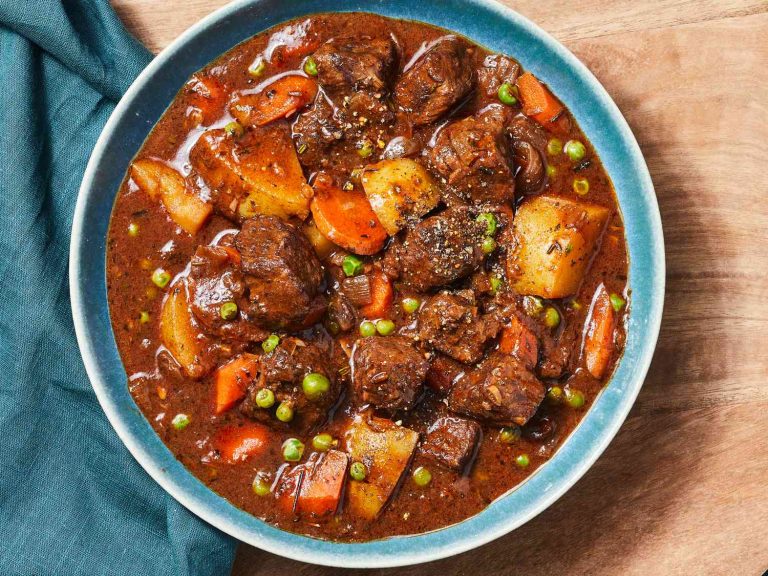Persian Duck Fesenjan: A Traditional Recipe from Gilan Province
Duck Fesenjan is a traditional Persian dish dating back to ancient Persia. Derived from Gilan province in northern Iran, Fesenjan, or “Fesenjoon,” is a staple in Persian cuisine often served at festive occasions. Historical significance and regional influences shape its preparation, making it unique compared to other stews.
Key Ingredients and Flavor Profile
Duck Fesenjan features a combination of rich and flavorful ingredients.
- Duck: The primary protein, adding a gamey taste, traditionally complements the dish’s bold flavors.
- Pomegranate Molasses: Provides the dish with a sweet and tangy essence, balancing the richness of the duck.
- Ground Walnuts: Impart a creamy texture and nutty flavor, integral to Fesenjan’s distinctive taste.
- Spices: Typically include turmeric, cinnamon, salt, and pepper, enhancing the depth of the dish’s flavor profile.
- Onions: Offer a foundational sweetness and aroma to the stew.
The combination of these ingredients results in a complex, rich taste, marking Duck Fesenjan a distinct and celebrated dish in Persian culinary traditions.
Preparing the Duck for Fesenjan
Choosing the Right Duck
Select a high-quality, fresh duck to ensure the best results in your Fesenjan. Opt for a duck weighing between 4 to 5 pounds, which provides a balance of meat and fat ideal for this dish. Look for ducks labeled “free-range” or “organic,” as these often yield better flavor and texture. Ensure the duck has a uniform, plump appearance with no discoloration or unpleasant odors.
Essential Preparation Techniques
Before cooking, clean the duck thoroughly under cold water and pat it dry with paper towels. Remove any excess fat around the cavities to avoid a greasy texture in your stew. Score the skin in a crosshatch pattern without cutting into the meat, promoting even rendering of the fat and crispier skin.
Carve the duck into six pieces: two legs, two wings, and two breast halves. Use a sharp knife to make clean cuts, reducing the risk of tearing the meat. Season the pieces with salt and pepper to enhance the flavor base and prepare them for the subsequent cooking steps.
For an even more luxuriant dish, marinate the duck pieces in a mixture of pomegranate molasses, olive oil, minced garlic, and a pinch of saffron. Cover and refrigerate the duck for at least 4 hours, or overnight if possible, allowing the flavors to penetrate deeply into the meat.
By following these preparation steps, you’ll ensure your Duck Fesenjan has a rich, tender, and flavorful foundation.
The Art of Cooking Duck Fesenjan
Step-by-Step Cooking Process
Start by heating a large pan over medium heat. Add two tablespoons of olive oil. Once the oil heats up, place the duck pieces skin-side down. Sear until both sides turn golden brown, taking around 4-5 minutes per side. Remove the duck and set it aside.
In the same pan, add one finely chopped onion. Cook until it turns translucent, about 5 minutes. Add a pinch of salt and stir. Next, add a cup of ground walnuts, sautéing for 2-3 minutes. Pour in two cups of pomegranate molasses, stirring constantly. Combine the seared duck pieces back into the pan.
Pour three cups of chicken broth into the mixture. Lower the heat to a simmer, cover, and let it cook for 1.5 hours. Stir occasionally. Add a teaspoon of saffron steeped in warm water during the last 15 minutes of cooking.
Tips for Achieving the Perfect Consistency
Maintain a slow simmer to prevent overcooking. This ensures the duck remains tender. Stir often to prevent the sauce from sticking to the pan.
Adjust the liquid levels by adding more broth if the sauce thickens too quickly. If the sauce is too thin after cooking, let it simmer uncovered for an additional 15-20 minutes. Ensure that the ground walnut mixture evenly incorporates to achieve a velvety texture.
Taste and adjust the seasoning by adding salt and pepper to suit your preference. If the sauce tastes too tart, mix in a teaspoon of honey to balance the flavors.
Serving and Pairing Duck Fesenjan
Traditional Presentation Styles
Duck Fesenjan typically takes center stage in a Persian meal. Tradition dictates serving it in a large, shallow bowl to showcase its rich, dark sauce. Provide a generous portion of duck pieces, ensuring each has a fair amount of sauce and nuts. Garnish with pomegranate seeds and finely chopped parsley to enhance both flavor and appearance. Serve it hot to maintain its rich taste and texture.
Recommended Accompaniments and Wine Pairings
Complement Duck Fesenjan with Persian rice, like Basmati or saffron-infused rice, to soak up the flavorful sauce. Side dishes like Shirazi salad, with cucumbers, tomatoes, red onions, and fresh herbs, add a refreshing contrast. For wine, choose a bold red like Syrah or Zinfandel, which pairs well with the tangy and nutty flavors of the stew. Non-alcoholic options include pomegranate juice and black tea for an authentic experience.
Conclusion
Duck Fesenjan offers a rich and flavorful journey into Persian cuisine. Its unique blend of ingredients creates a dish that’s both hearty and exotic. By marinating the duck and carefully simmering the stew, you can achieve a depth of flavor that’s truly remarkable. Serving it with Persian rice and a glass of Syrah elevates the experience to a new level. Whether you’re a seasoned cook or a culinary novice, Duck Fesenjan is a rewarding dish that brings a touch of Iran’s rich culinary heritage to your table. Enjoy the process and savor each bite.






